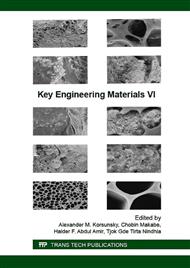p.291
p.297
p.304
p.309
p.315
p.323
p.332
p.338
p.345
Effect of Hydroxyapatite: Fibroin Ratio on Hydroxyapatite/Fibroin/Chitosan Porous Scaffold Characteristics
Abstract:
Autografting is a bone replacement technique used in orthopedic surgery. Bone tissue engineering is a new technique that offers promise, and could help alleviate this risk. Bioceramics, biopolymers or composite can be fabricated for artificial bone scaffold and used for bone regeneration. This study used three types of biomaterials – hydroxyapatite (HA), fibroin, and chitosan – to form porous scaffold. HA and fibroin were prepared from natural materials. HA was synthesized from mollusk shell by wet chemical precipitation method, while silk fibroin was extracted from silk worm’s cocoons. The HA and fibroin were mixed in a variety of ratios along with a fixed amount of chitosan before fabricating composite porous scaffolds by freeze-drying. The resulting scaffolds were evaluated for biodegradability, biocompatibility, porosity pore morphology and mechanical property. The fabricated scaffolds had an interconnected porous structure with a pore size of 200-400 μm and porosity in a range of 93-95%. The average degradation rate of the scaffold in lysozyme was between 7-17% at 7 days. A biocompatibility test showed that the scaffold was non-cytotoxic, making it a good candidate for future bone tissue engineering applications.
Info:
Periodical:
Pages:
315-319
Citation:
Online since:
August 2016
Keywords:
Price:
Сopyright:
© 2016 Trans Tech Publications Ltd. All Rights Reserved
Share:
Citation:


